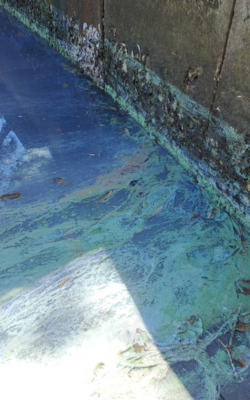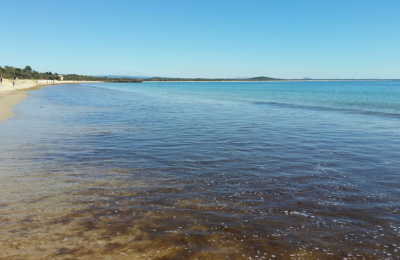Algal Blooms

Trichodesmium
What is Trichodesmium?
Our subtropical climate on the Sunshine Coast provides warm and sunny conditions. These conditions can assist Trichodesmium to bloom in our waters. Trichodesmium are Cyanobacteria (blue-green algae) that appear naturally in tropical and subtropical ocean waters and are commonly known as sea sawdust, whale sperm, whale food and sea scum.
However, during extended calm periods gas vacuoles cause it to rise to the water surface. Once at the surface it forms clumps which on close inspection appear to consist of little brown bundles of threads.
These bundles are just visible to the naked eye, appearing like tiny flecks of sawdust floating on or near the surface. The combination of calm conditions, northerly currents and warm water temperatures causes increased growth, with cell density often becoming great enough to colour the water creating a bloom.
Trichodesmium blooms - what to look for
Trichodesmium blooms are often visible in the waterways and surrounding ocean of the Sunshine Coast region. The blooms can occur throughout the year but are most common between August and January when they can form very large slicks. Blooms are typically a rusty-brown colour, however some variations in colour may occur with grey, green and purple streaks being observed.
Are they toxic?
In most cases the blooms are harmless but if they deplete the oxygen content of the water, they can cause death to aquatic animals. If allowed to stagnate, Trichodesmium can release a clear, water soluble toxin. This is indicated by a change in colour of the Trichodesmium filaments from a rusty brown colour to a green colour accompanied by the release of a pigment which will colour the water pink. It is this pink colour in the algae that reportedly gave the Red Sea its name.
Generally, the concentration of this toxin in natural systems is not sufficiently high enough to pose a threat to human health. Trichodesmium can be easily washed off the skin by rinsing with water. Under certain conditions these blooms or slicks may become beached. As a precaution, swimming and primary contact with water containing an active Trichodesmium bloom should be avoided.
This beaching can result in a putrid, almost ‘fishy’ smell along the beach.

Hincksia sordida
What is Hincksia sordida?
Between 2002 - 2012, and again in 2017, a brown alga known as Hincksia sordida washed up on Noosa’s Main Beach in large quantities during spring/early summer, coinciding with popular holiday periods and recreational use of the beach. The algae formed dense accumulations in the surf zone and washed up on the sand in large quantities on outgoing tides. It was visually unappealing and smelt unpleasant as it decomposed, affecting tourists’ and locals’ enjoyment of the beach. The Hincksia blooms worsened with north-easterly winds and were cleared from the surf zone by south-easterly winds. Council monitored the beach for signs of blooms and cleared the algae as needed.
Why is Hincksia here?
Hincksia typically grows in sheltered habitats n the Noosa River Estuary, Moreton Bay and in other aquatic systems in southern Australia (Phillips, 2006). It is a naturally occurring, non-toxic alga, and it is difficult to predict when it may occur and identify ways to reduce it.
Research undertaken on coastal algal blooms indicates that higher than normal presence of nutrients in waterways may contribute to algal blooms (Phillips, 2006). Elevated nutrients may at times come from natural and/or human sources. Regular waterways health monitoring helps to identify potential nutrient sources and inform management decisions.
Coastal algal blooms can persist for several weeks or even months. The duration of the bloom depends on the availability of nutrients, flow conditions and the weather.
Is it toxic?
It is important to note that Hincksia is naturally occurring and non-toxic.
Algal monitoring program
Since 2017, Council has been undertaking an algal monitoring program to identify visual signs of Hincksia sordida and other alga. Visual identification at 16 locations in the Noosa estuary is undertaken on a monthly schedule during algal bloom season from July – February each year.
There have been no Hincksia blooms observed for several years, however in November 2023 Council’s monthly algal monitoring program detected a Hincksia species and Trichodesmium within some bloom material. Council activates its Hincksia Action Plan in these circumstances and will continue to monitor the situation and undertake clean up works as required.
